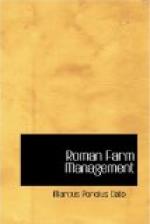Since now forsooth most of our gentry crowd into town, abandoning the sickle and the plough and prefer to exercise their hands in the theatre and the circus rather than in the corn field and the vineyard, it has resulted that we must fain buy the very corn that fills our bellies and have it hauled in for us, yea, out of Africa and Sardinia, while we bring home the vintage in ships from the islands of Cos and Chios!
And so it has happened that those lands which the shepherds who founded the city taught their children to cultivate are now, by their later descendants, converted again from corn fields back to pastures, thus in their greed of gain violating even the law, since they fail to distinguish the difference between agriculture and grazing.[106] For a shepherd is one thing and a ploughman another, nor for all that he may feed his stock on farm land is a drover the same as a teamster: herded cattle, indeed, do nothing to create what grows in the land, but destroy it with their teeth, while the yoked ox on the contrary conduces to the maturity of grain in the corn fields and forage in the fallow land. The practice and the art of the farmer is one thing, I say; that of the shepherd another; the farmer’s object being that what ever may be produced by cultivating the land should yield a profit; that of the shepherd to make his profit from the increase of his flock; and yet the relation between them is intimate because it is much more desirable for a farmer to feed his forage on the land than to sell it, and a herd of cattle is the best source of supply of that which is the most available food of growing plants, namely, manure:[107] so it follows that whoever has a farm ought to practise both arts, that of agriculture and that of grazing cattle, indeed, also that of feeding game, as is done at our country houses, since no little profit may be derived from aviaries and rabbit warrens and fish ponds. And since I have written a book concerning the first of these occupations—that of the husbandry of agriculture—for my wife Fundania because of her interest in that subject, now, my dear Turranius Niger, I write this one on the husbandry of live stock for you, who are so keen a stock fancier that you are a frequent attendant at the cattle market at Macri Campi, where, by your fortunate speculations, you have found means to make provision for many crying expenses.
I could do this on my own authority because I am myself a considerable owner of live stock with my flocks of sheep in Apulia and my stud of horses at Reate, but I will run through the subject, briefly and summarily rehearsing what I gathered from conversation with certain large stock feeders in Epirus at the time when, being in command of the fleet in Greece during the war with the pirates, I lay between Delos and Sicily.[108]
Of the origin, the importance and the economy of live stock husbandry
I.[109] When Menates had gone, Cossinius said to me: “We shall not let you go until you have explained those three points which you began to discuss the other day when we were interrupted.”




